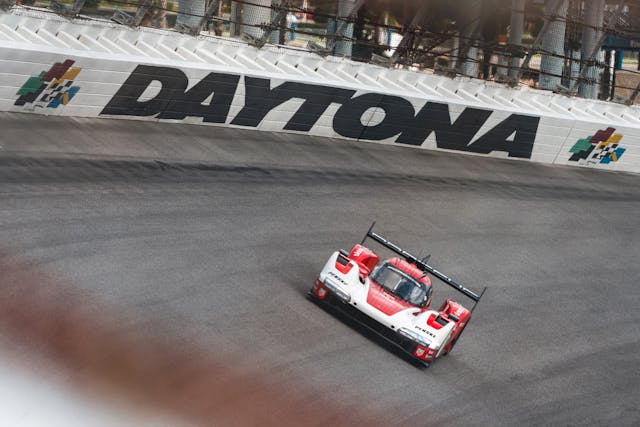Manufacturers testing at Daytona have racing’s Triple Crown in their sights
Last Friday morning, the crackle of three very different-sounding race engines—a Porsche, an Acura, and a pair of Cadillacs—broke the silence during a joint test at the Daytona International Speedway road course.
It was aural confirmation that a change is coming. A change that will impact global sports car racing.
The noise was from three IMSA WeatherTech SportsCar Championship GTP cars—brand-new models that will debut at the Rolex 24 at Daytona on January 28-29. Along with Porsche, Acura, and Cadillac, BMW is going to compete (they were testing in Europe) and Lamborghini will join in 2024.
So what’s the big deal with these new cars, and why did we shove off to Daytona to hear them fire up?

For years, the Daytona-based, NASCAR-owned IMSA sanctioning body and its Europe-based counterpart, the World Endurance Championship, have run very different prototype cars. The prototypes that IMSA raced, the Daytona Prototype international, or DPi, couldn’t compete in WEC races due to a different set of rules, and vice versa.
That meant crowning a true world champion was impossible. It also meant that one manufacturer couldn’t win the trifecta of sports car racing—the 24 Hours of Le Mans, the Rolex 24 and the Twelve Hours of Sebring—because the WEC sanctions Le Mans, and IMSA sanctions Daytona and Sebring.
For years, the manufacturers have lobbied for a change, but nothing happened until 2020. That’s when it was announced at that year’s Rolex 24 that IMSA and WEC agreed on one common formula, a 670-horsepower sports car that could run the entire IMSA and WEC schedule, as well as the Big Three of sports car races. One car, two championships, and maybe a true king of the hill. The marketing opportunities would be boundless.
At the announcement in 2020, the car was called the LMDh, or Le Mans Daytona hybrid; despite the name, the cars will be gasoline-powered, with a small hybrid component that should allow the cars to get on and off pit road under electric power.
All the LMDh cars would be built to a basic design by several different chassis manufacturers. The bodies look very similar, but underneath, the cars are quite different. Cadillac, Porsche, and BMW will run V-8 engines, and Acura will run a V-6 since neither Acura nor Honda has a V-8. Hybrid systems will be identical.

At Friday’s test, Acura and Cadillac kept to themselves, no media allowed. But Porsche opened its garages for an up-close look at the car it calls the 963, and we spoke to multiple drivers and executives about the car. The team is called Porsche Penske Motorsport, because Porsche has once again teamed with 85-year-old Roger Penske to run its program.
Penske ran a successful Porsche LMP2 team 10 years ago before IMSA and the American Le Mans Series merged into IMSA, but the LMP2 cars were too underpowered to go for the overall win at Le Mans. That’s the one jewel left that Roger Penske wants in his crown, which includes NASCAR Championships, IndyCar championships and Indianapolis 500 victories. Odds are if any company can give Penske a Le Mans win, it’s possibly Porsche.
Outside, the IMSA GTP cars look a lot like the outgoing DPi cars, but they are all new and quite different. Dane Cameron is the only American Porsche driver, and he won the 2019 IMSA championship with Juan Pablo Montoya in an Acura-powered Penske DPi. He has more miles in the Porsche 963 than any other driver, and says the DPi and the GTP are similar, but hardly identical.

“In a lot of ways it’s very familiar, and in other ways it’s different—it’s driven by regulations, different weight targets, different downforce targets—so in some ways it’s definitely new. It’s a bit more complex with the hybrid component. But at the end of the day it’s still an LMP-style car so it’s familiar in a lot of ways.
“The DPi car is very high downforce, a little lower horsepower. Now we’re on a lower-downforce target, higher weight, again all by regulations, and a little more engine power. It’s quicker in the straights, and maybe a little slower in some of the high-speed corners.”
Cameron is looking forward to Daytona, with reservations. “It’s going to be incredibly difficult,” Cameron says, since the all-new car debuts at IMSA’s longest and most important race. “We have these big regulations changes, which we’re proving here at all this testing, but the changes can’t be race-proven, if you want to use that term. To roll it all out at the very first race is difficult.”
“I’m excited about it; I’m excited to see this class’s numbers pump back up, I’m excited to see all the new manufacturers enter this category, and I’m excited to see the manufacturers happy with this ruleset. It’s going to be great for the drivers and the teams and the fans.”

By the end of the two-day test, Porsche had logged a grand total of 10,314 miles in tests in Europe and the U.S., and there’s a lot more to come for all the manufacturers.
But it has been proven time and time again that all the testing in the world can’t always match the demands of an actual race, and Daytona is one of the toughest. One example: The Ford GT’s debut at Daytona in 2016. After exhaustive and nearly trouble-free pre-season testing, the two cars finished a problem-plagued 31st and 40th.
Will the GTP cars fare better? And will anyone succeed in earning a Daytona, Sebring, and Le Mans hat trick? We’ll find out starting in January.
Check out the Hagerty Media homepage so you don’t miss a single story, or better yet, bookmark it.


